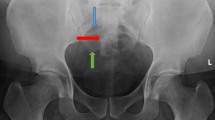Abstract
Primary sacrum undifferentiated pleomorphic sarcoma (UPS) is an extremely rare malignant lesion. Furthermore, sacral tumor is often an uncontrollable condition, because the first diagnosis is usually made at advanced stage in the patients of sacral tumors. In this article, we report a patient with sacrum UPS, who showed aggressive local recurrence and early progression of multiple metastases in major organs after palliative surgery, resulting in the occurrence of a U-shaped sacrum pathological fracture requiring stabilization from the fourth lumbar to the ilium. An 87-year-old male patient showed progressively worsening gait difficulty following bladder and bowel dysfunction because of the presence of a sacrum tumor. Palliative surgery (laminectomy) from the first to the third sacrum (S) and tumor excision were performed. His neurological dysfunction tended to recover after surgery. However, a U-shaped sacrum pathological fracture occurred. Percutaneous stabilization from the fourth lumbar to the ilium was performed during the second postoperative week. The findings were consistent with those of a UPS. The patient was able to transfer from the bed to a wheel chair. However, his general condition deteriorated, with multiple organ metastases, and he expired because of respiratory insufficiency caused by the UPS 2 months after stabilization. Sacral stabilization should be considered for patients with an invaded S1–2 pedicle because of the potential occurrence of S1 pedicle and sacrum fractures. Palliative treatment with only radiation and analgesic agents after needle biopsy might have been another option, considering the age and the biological nature of sacral UPS.




Similar content being viewed by others
References
Fletcher CD. The evolving classification of soft tissue tumours–an update based on the new 2013 WHO classification. Histopathology. 2014;64(1):2–11.
Zhou N, Schafer R, Li T, Fang M, Liu L. A primary undifferentiated pleomorphic sarcoma of the lumbosacral region harboring a LMNA-NTRK1 gene fusion with durable clinical response to crizotinib: a case report. BMC Cancer. 2018;18(1):842.
Dahlin DC, Unni KK, Matsuno T. Malignant (fibrous) histiocytoma of bone-fact or fancy? Cancer. 1977;39(4):1508–16.
Huvos AG, Heilweil M, Bretsky SS. The pathology of malignant fibrous histiocytoma of bone. A study of 130 patients. Am J Surg Pathol. 1985;9(12):853–71.
Teng H, Xinghai Y, Wei H, Huang Q, Xiao J, Zhang C. Malignant fibrous histiocytoma of the spine: a series of 13 clinical case reports and review of 17 published cases. Spine (Phila Pa 1976). 2011;36(22):E1453–62.
Reynolds JJ, Khundkar R, Boriani S, Williams R, Rhines LD, Kawahara N, et al. Soft tissue and bone defect management in total sacrectomy for primary sacral tumors: a systematic review with expert recommendations. Spine (Phila Pa 1976). 2016;41(Suppl 20):S199–204.
Feldman F, Norman D. Intra-and extraosseous malignant histiocytoma (malignant fibrous xanthoma). Radiology. 1972;104(3):497–508.
Somasundaram A, Wicks RT, Lata AL, Qasem SA, Hsu W. En bloc spondylectomy for primary malignant fibrous histiocytoma of the thoracic spine with aortic involvement: case report. J Neurosurg Spine. 2015;22(4):399–405.
Hugate RR Jr, Dickey ID, Phimolsarnti R, Yaszemski MJ, Sim FH. Mechanical effects of partial sacrectomy: when is reconstruction necessary? Clin Orthop Relat Res. 2006;450:82–8.
Yu B, Zheng Z, Zhuang X, Chen H, Xie D, Luk KD, et al. Biomechanical effects of transverse partial sacrectomy on the sacroiliac joints: an in vitro human cadaveric investigation of the borderline of sacroiliac joint instability. Spine (Phila Pa 1976). 2009;34(13):1370–5.
Acknowledgments
We would like to thank H. Takeda for the preparation of histopathological staining.
Author information
Authors and Affiliations
Corresponding author
Ethics declarations
Conflict of Interests
The authors declare that they have no conflict of interest.
Ethical Approval
Not applicable.
Informed Consent
Written informed consent was obtained from the patient for publication of this case report and any accompanying images.
Additional information
Publisher’s Note
Springer Nature remains neutral with regard to jurisdictional claims in published maps and institutional affiliations.
This article is part of the Topical Collection on Surgery
Rights and permissions
About this article
Cite this article
Tsujimoto, T., Iwata, A., Kajino, T. et al. A Case Report of Huge Sacrum Undifferentiated Pleomorphic Sarcoma Treated with Two Separate Surgeries of Decompression and Stabilization. SN Compr. Clin. Med. 2, 667–671 (2020). https://doi.org/10.1007/s42399-020-00288-y
Accepted:
Published:
Issue Date:
DOI: https://doi.org/10.1007/s42399-020-00288-y




